
Laura Locoul Gore (1861-1963), whom the restored Laura Plantation is named after, wrote her memoirs of the plantation in 1936 detailing daily life and major events of the plantations inhabitants (I bought a copy and am currently reading). Much of the tour was based on this information, some of which I will relay to you now…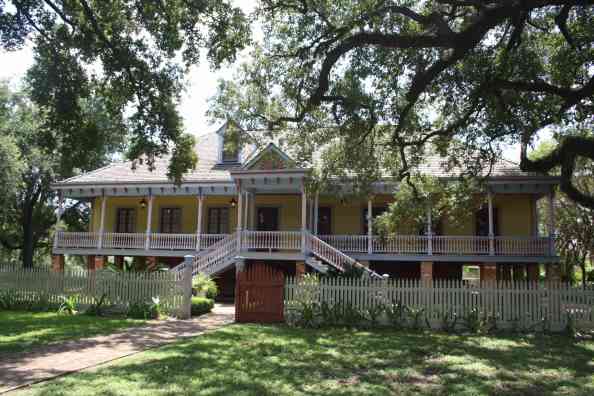 In 1804 Guillaume Duparc (Laura’s great grandfather), a French naval veteran, applied to Thomas Jefferson for land and was given the valuable plot of land the plantation stands on. Pictured above is the main family home built in 1805, originally known as l’habitation Duparc, it is a colourful house which is distinctly Creole. The Louisiana Creole people are those descended mainly from French and Spanish colonial settlers. They planted large oak trees next to their houses to create shade from the heat and had lots of doors to allow a through breeze, much needed in the heat of the summer (35c/95f when we visited at the end of July).
In 1804 Guillaume Duparc (Laura’s great grandfather), a French naval veteran, applied to Thomas Jefferson for land and was given the valuable plot of land the plantation stands on. Pictured above is the main family home built in 1805, originally known as l’habitation Duparc, it is a colourful house which is distinctly Creole. The Louisiana Creole people are those descended mainly from French and Spanish colonial settlers. They planted large oak trees next to their houses to create shade from the heat and had lots of doors to allow a through breeze, much needed in the heat of the summer (35c/95f when we visited at the end of July).
The house was the business headquarters, the family lived there but would spend spring in one of their townhouses in New Orleans. Business and family were inextricably linked and you could not have one without the other. The unusual but pleasing part of creole culture is that they would hand the business down to the smartest child, Guillaume bypassed his 2 eldest sons and put his daughter Elisabeth in charge. The business continued to be passed down to female family members which pleases my inner feminist deeply!
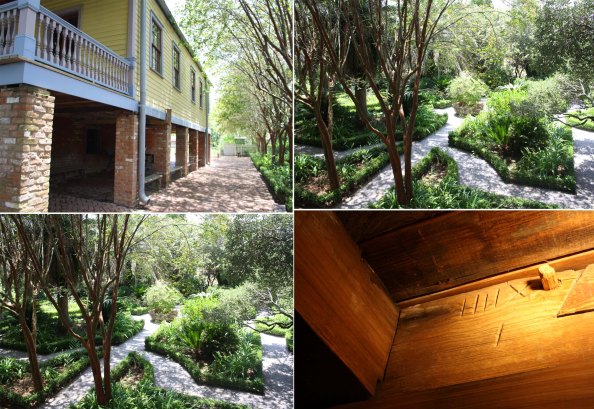 The pictures above show some details of the architecture, top left you can see the house is on stilts, this is because the ground in this part of the world is not solid and the houses can sink into the swamp, the foundations go 8 feet below ground level. The gardens were planted in the French classical style. The picture bottom right was taken underneath the house and if you can read the roman numerals, they count the number of beams and thus the width of the structure .
The pictures above show some details of the architecture, top left you can see the house is on stilts, this is because the ground in this part of the world is not solid and the houses can sink into the swamp, the foundations go 8 feet below ground level. The gardens were planted in the French classical style. The picture bottom right was taken underneath the house and if you can read the roman numerals, they count the number of beams and thus the width of the structure .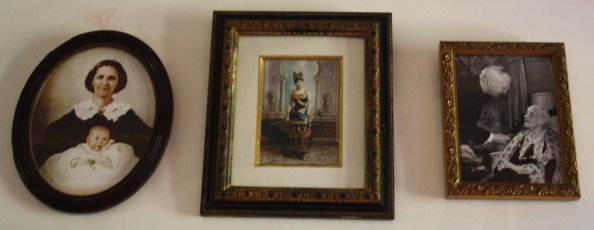 The pictures above recount the various stages of Laura’s life, left you see Laura as a baby in the foreground. The middle picture is Laura as ‘Mephistopheles’ at the Semme Debut Fancy Dress Ball in 1886. On the right we see John Cardinal Ritter greeting Laura on her 100th birthday in 1961.
The pictures above recount the various stages of Laura’s life, left you see Laura as a baby in the foreground. The middle picture is Laura as ‘Mephistopheles’ at the Semme Debut Fancy Dress Ball in 1886. On the right we see John Cardinal Ritter greeting Laura on her 100th birthday in 1961.
Laura’s memoirs teach us about growing up on a plantation, when she was about 7 she was speaking to Pa Philippe ‘a weather beaten’ slave.
“On his creased and wrinkled old face I saw the letters ‘V.D.P.’ I pointed my finger to his face and asked, “Oh Philippe, what is that mark on your forehead?” He turned and laughed in a hard, cackling, old voice saying, “Lord, child, don’t you know this is where they branded me when I used to run away?” I was horror stricken and ran into the house to my mother saying, “Oh, Mamma, they branded Philippe like they do cattle. I saw it. He told me so. Who did it, Mamma?”
p39 Memories of a Plantation Homes by Laura Locoul Gore
Her mother did her best to explain, but this left a lasting impression on Laura and she always tried to be kind after that. As a young woman she never wanted to run the business but she ended up doing so.
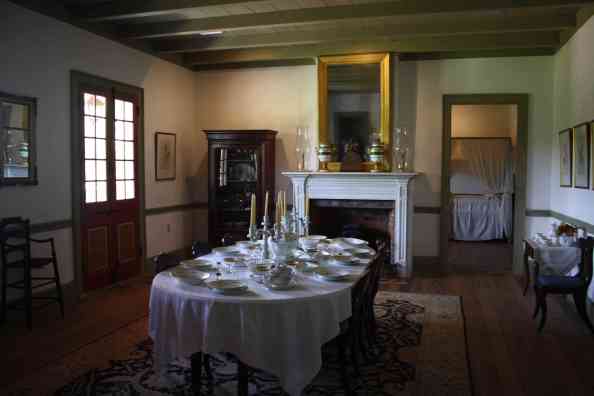 Above is the family dining room where Laura told her family about her secret 6 year engagement to a non-Catholic, Charles Gore, she also thought they should sell the plantation, which they did, to a German family. After this they moved to St Louis, Missouri.
Above is the family dining room where Laura told her family about her secret 6 year engagement to a non-Catholic, Charles Gore, she also thought they should sell the plantation, which they did, to a German family. After this they moved to St Louis, Missouri. 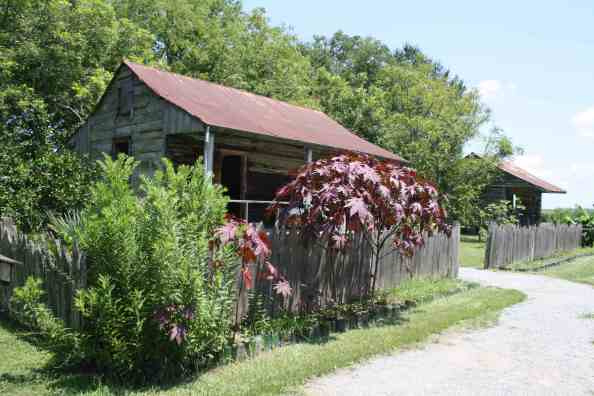 Above you can see pictured one of the original sixty-nine field slave quarters, about 300ft from the main house. Sugar plantations played a sour role in the history of the slave trade, this is the reason I had heard of them and what I’d expected to learn more about on our guided tour of the Laura Plantation. About 50 minutes of the 1hr tour was spent discussing the family that ran the plantation and more specifically on Laura Locoul Gore. This is not a criticism, although I would liked to have known more about the slaves experience, the tour was extremely interesting and I did learn a lot.
Above you can see pictured one of the original sixty-nine field slave quarters, about 300ft from the main house. Sugar plantations played a sour role in the history of the slave trade, this is the reason I had heard of them and what I’d expected to learn more about on our guided tour of the Laura Plantation. About 50 minutes of the 1hr tour was spent discussing the family that ran the plantation and more specifically on Laura Locoul Gore. This is not a criticism, although I would liked to have known more about the slaves experience, the tour was extremely interesting and I did learn a lot.
British colonists referred to sugar as white gold, and it is the reason millions of Africans were brought to the Americas as slaves. The average price for a slave was, in todays money, $25,000. There was a code of conduct whereby slaves should be given food, shelter, clothing, didn’t work Sundays as it was the Catholic day of rest and families shouldn’t be separated – this was not really enforced especially in the rural communities where most plantations existed. We heard a few stories about Elisabeth’s cruelty.
History is usually written by the victor and I guess the majority of slaves would not have been able to write so the information is limited. Laura Plantation is one of the places where Alcee Fortier recorded the folktales of Compair Lapin, more commonly known as Brer Rabbit, from West African slave descendants. Pictured above is one of the many plants in the kitchen garden, it would’ve been over 10 acres when the house was at its busiest. There were lots of fruit and vegetables still flourishing there.
Pictured above is one of the many plants in the kitchen garden, it would’ve been over 10 acres when the house was at its busiest. There were lots of fruit and vegetables still flourishing there.
The house and plantation are beautifully kept, with sugar cane still growing out back. Our guide was engaging, informative and very knowledgable, she answered numerous questions at the end of the tour. If you are ever lucky enough to find yourself in Louisiana I suggest you pay Laura a visit.
Entry Fee: $18
Location: Laura, 2247 Highway 18, Vacherie, Louisiana, 70090
Posted on August 5, 2012 by The Exhibition List
0